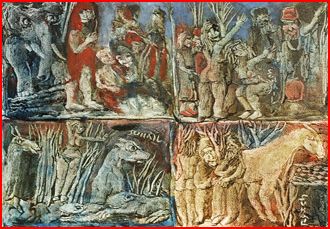Symbolist Wizadry
By Salwat Ali | Art | Arts & Culture | Published 18 years ago
It’s a delight to see an accomplished artist regain lost ground. From a slack earlier exhibition, Tasadaq Sohail has bounced back into form once again. A fresh collection of paintings on show at Clifton Art reaffirm the magic of his signature imagery. The current art may not have the vigour and spark of works executed during his prime, but his very personal world of pygmy people, mermaids, stray cats, a white mule, extraordinary fishes, medieval castles and ancient caves is as enigmatic as ever. It is this very eccentric, primordial content, presented through an equally primitive, somewhat chimerical vocabulary and novel technique, that draws one to a Tasadaq Sohail painting.
Sohail’s art is marked with a narrator’s sensibility. Incidentally, Sohail was a short story writer before painting became the passion of his life. He makes visual chronicles of life in an underworld of his creation. Bound with coded imagery, his narrative conforms to a symbolist manifesto which employs a systematic use of symbols or pictorial conventions to express an allegorical meaning. Not so much a style of art, symbolism was more an international ideological trend. Symbolists believed that art should apprehend absolute truths which could only be accessed indirectly. Thus, they painted scenes from nature, human activities, and other real world phenomena in a highly metaphorical and suggestive manner to produce images or objects with esoteric attraction.
 Like symbolist painters who used symbols from mythology and dream imagery for a visual language of the soul, Tasadaq Sohail too has invented a repertoire of signs, ciphers and oblique images to define his philosophy of life. In his figure drawings, body parts metamorphose into fantasy shapes or degenerate into ‘little pygmy people’ to enact the theatre of the absurd. This enables him to explore moral issues concerning male-female relationships, sexual freedom, taboos and anxieties, covertly without recourse to open confrontation. The symbols used are not the familiar emblems of mainstream iconography but intensely personal, private, obscure and ambiguous references. The female nude represents the liberated western woman who has turned her back on the past, the mermaid epitomises the mystery woman with one foot in this world and the other in the underworld and ladders and electric poles prompt readings into Freudian sexual politics. On a simpler note, the wooden horse mimics the Trojan counterpart and slithering snakes and bitten apples are rich with Edenesque connotations. Sohail is most comfortable recreating strange rituals in an obscure pagan or medieval culture. This aura of the ancient and prehistoric, veiled in the mysterious and the clandestine, distances his work from current reality. Other than stylistic nuances, it is this mystifying quality that prompts engagement with his compositions.
Like symbolist painters who used symbols from mythology and dream imagery for a visual language of the soul, Tasadaq Sohail too has invented a repertoire of signs, ciphers and oblique images to define his philosophy of life. In his figure drawings, body parts metamorphose into fantasy shapes or degenerate into ‘little pygmy people’ to enact the theatre of the absurd. This enables him to explore moral issues concerning male-female relationships, sexual freedom, taboos and anxieties, covertly without recourse to open confrontation. The symbols used are not the familiar emblems of mainstream iconography but intensely personal, private, obscure and ambiguous references. The female nude represents the liberated western woman who has turned her back on the past, the mermaid epitomises the mystery woman with one foot in this world and the other in the underworld and ladders and electric poles prompt readings into Freudian sexual politics. On a simpler note, the wooden horse mimics the Trojan counterpart and slithering snakes and bitten apples are rich with Edenesque connotations. Sohail is most comfortable recreating strange rituals in an obscure pagan or medieval culture. This aura of the ancient and prehistoric, veiled in the mysterious and the clandestine, distances his work from current reality. Other than stylistic nuances, it is this mystifying quality that prompts engagement with his compositions.
On a technical level, his work reaffirms the human figure, often naked, as subject. The nude is treated in an expressive manner, often with exotic birds, marine life or mythical creatures which symbolise the supremacy of subjectivity and imagination over reason. The anecdotal content in Sohail’s compositions, though enacted as fantasy, is almost always explicit. He philosophises on gender interaction by appealing to our animal instincts. As gross as it is titillating, this work is of a singular nature in our art milieu.
The artist has the rare ability to evoke conflicting states of beauty and ugliness simultaneously. Like an enchanting myth-maker, he veils the coarse and vulgar in his paintings with the magic and wonder of a fairytale. Bizarre and complex as they may appear, it is the gravity of the issues, cloaked in innuendoes, that define the core content of Sohail’s work.


